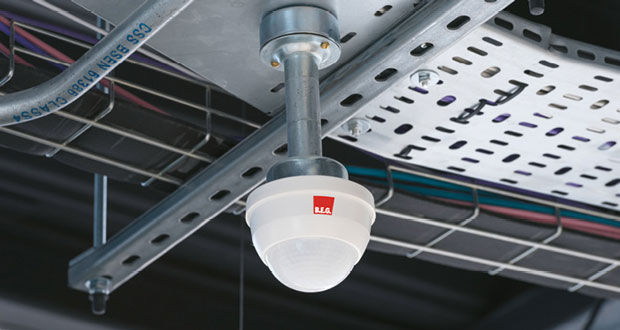 Paul Jones, UK & Ireland Sales Director for B.E.G. UK Ltd explains the practical ways DALI-based systems are helping buildings achieve smart optimum lighting control
Paul Jones, UK & Ireland Sales Director for B.E.G. UK Ltd explains the practical ways DALI-based systems are helping buildings achieve smart optimum lighting control
An automated DALI (Digital Addressable Lighting Interface) lighting control system uses highly accurate multi-sensors to control the artificial light in a building, depending on occupancy and brightness.
At the installation stage, a system integrator will attend the site, supported by technical engineers. Here, they can then align the system and building and clearly define the necessary rules and user authorisations to ensure that FMs can access precisely the most relevant part of the system for their needs.
Once the system is in place, staff can activate the lighting via a light switch upon entering their space. The multi-sensor then takes over intelligent control of the lighting. Thanks to the passive infrared sensor (PIR), movement is then detected and depending on the programming, the light is automatically switched on and off.
In addition to the PIR sensors detecting motion, the multi-sensors feature brightness detectors through which a daylight-dependent control of the lighting can be achieved. Having measured this the multi-sensor only adds or dims as much artificial light as is necessary to reach the pre-set lux value.
To achieve the optimal function of the intelligent system, the measured brightness value needs to be extremely accurate. This is achieved by finding the best location on the ceiling for the installation, where measurement is influenced as little as possible by external factors such as reflection, direct sunlight, or other light sources. Brightness values should be measured in the darkest part of the room, which may differ from room to room depending on its location in the building. However, the detection range of the unit must of course ensure adequate cover of the occupants’ range of mobility in the room.
OPTIMAL CONTROL
For optimal lighting control, the difference between the brightness at the desk and the brightness at the ceiling must be balanced in the logic of the multi-sensor. This means the actual value measured by the light sensor on the ceiling is not used for the control in order to supplement the natural light with the appropriate amount of artificial light. Instead, a so-called reflection factor is used as the ratio of light between the work surface and the ceiling.
With a DALI-based system, the weighting of the reflection value is set individually according to the environmental variables of the respective place of use. Here, the ratio can be set between 1:1 to 1:5 according to the lighting conditions in the room. In rooms with light floors and light furniture, the ratio between ceiling and work surface is 1:1, in rooms with dark floors and dark furniture 1:5. If required, this automatic control can be overridden.
If the occupant wants more or even less brightness, they can use the additional pushbutton to dim the light up or down. Alternatively, they can also intervene in the lighting control system via PC.
By means of a username and password, staff can be given access to areas in which they can influence the lighting control. They can log in via their browser and control the light in their room or office and via a user-friendly interface, can select scenes, and switch and dim the light as appropriate.
In a specific meeting room or boardroom staff can also control the light via a smartphone. These scenes are stored in the system for different meeting situations, which can be called up with a click.
For this purpose, the luminaires in the room are divided into groups and assigned dimming values. Staff can then switch from the ‘meeting’ scene with full illumination of the conference table to the ‘presentation’ scene with dimmed light in the area of the projection screen.
SWARM INTELLIGENCE
A special function of a DALI-based system is called ‘guided light’, which is also known on the market as ‘swarm intelligence’. With this function, luminaire groups are synchronised across DALI lines. When movement is detected, not only the luminaire group in which the movement is detected switches on the light. The adjacent luminaire groups also react, but with dimmed light.
Being surrounded by a ‘cloud of light’ that dims towards the outside, the user can see what is happening in the adjacent areas at all times, rather than looking from a brightly lit area into a pitch-black area. This function is ideal for use in staircases, corridors or open-plan offices. Thanks to dimming, the use of a ‘Guided Light’ function is more cost-effective than the usual complete 100 per cent lighting.
LINKING TO A ROUTER
The connection of a DALI-based system to a higher-level building management system (BMS) or to parallel existing systems for other functions such as heating, ventilation, blind control or access control can be done via a BACnet router.
This offers additional functions such as remote maintenance or the software update of control devices. Maintenance can then be facilitated via a quick system overview and automatic error notifications, while the lighting duration of individual lamps or the energy consumption of the system can be viewed transparently at any time.
A system administrator can monitor, configure and maintain the systems via PC or mobile devices for optimal user-friendly and environmentally friendly lighting.





